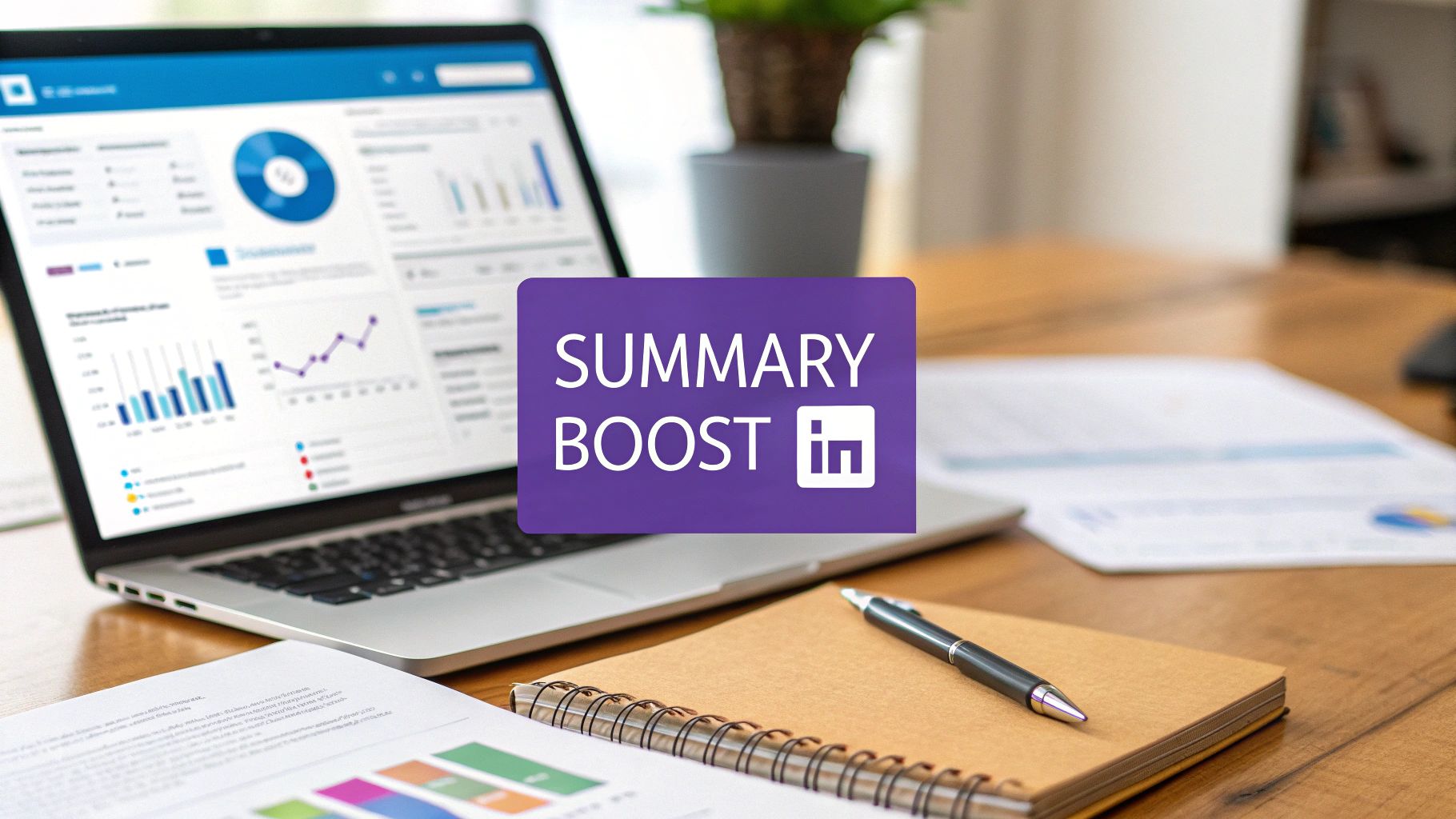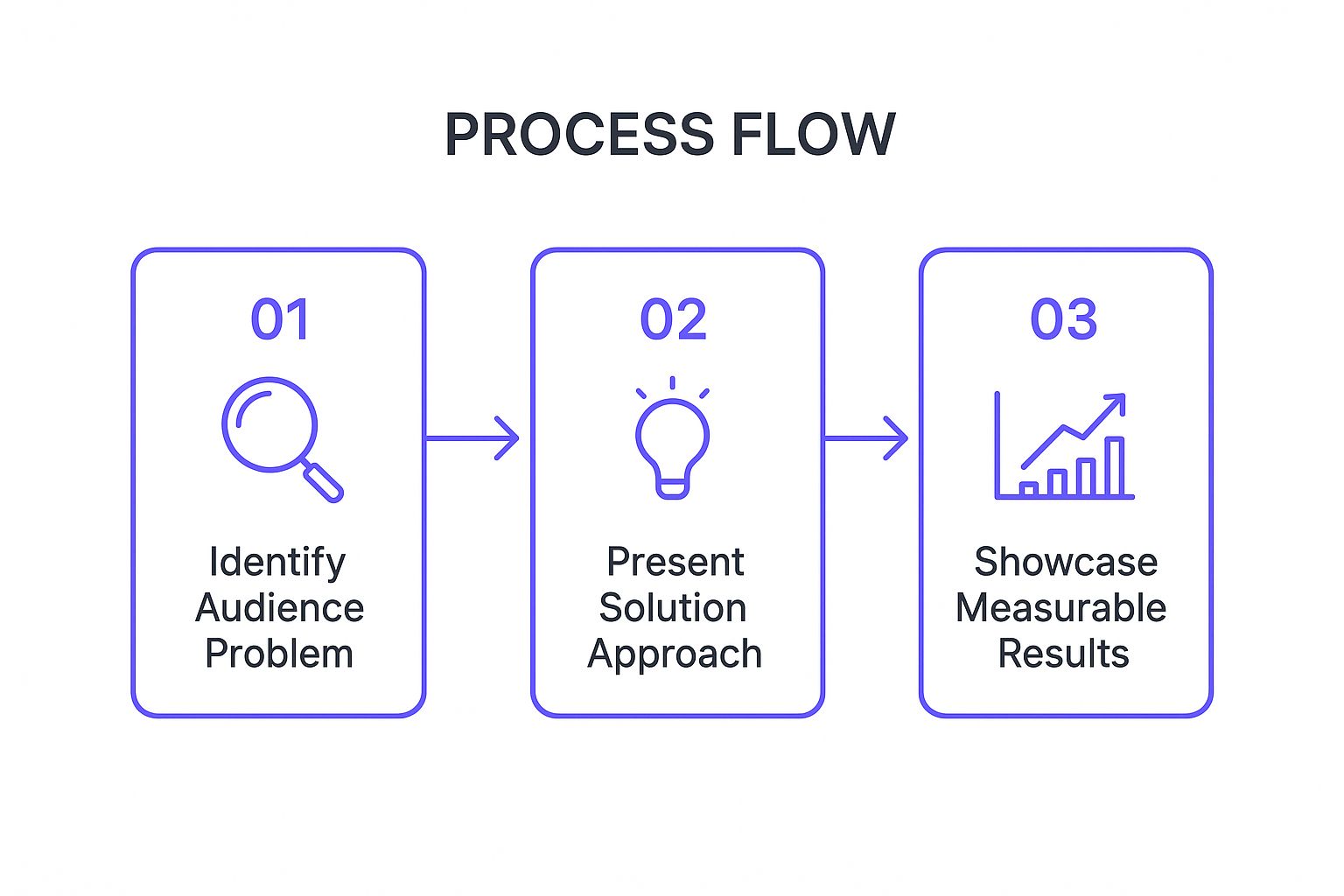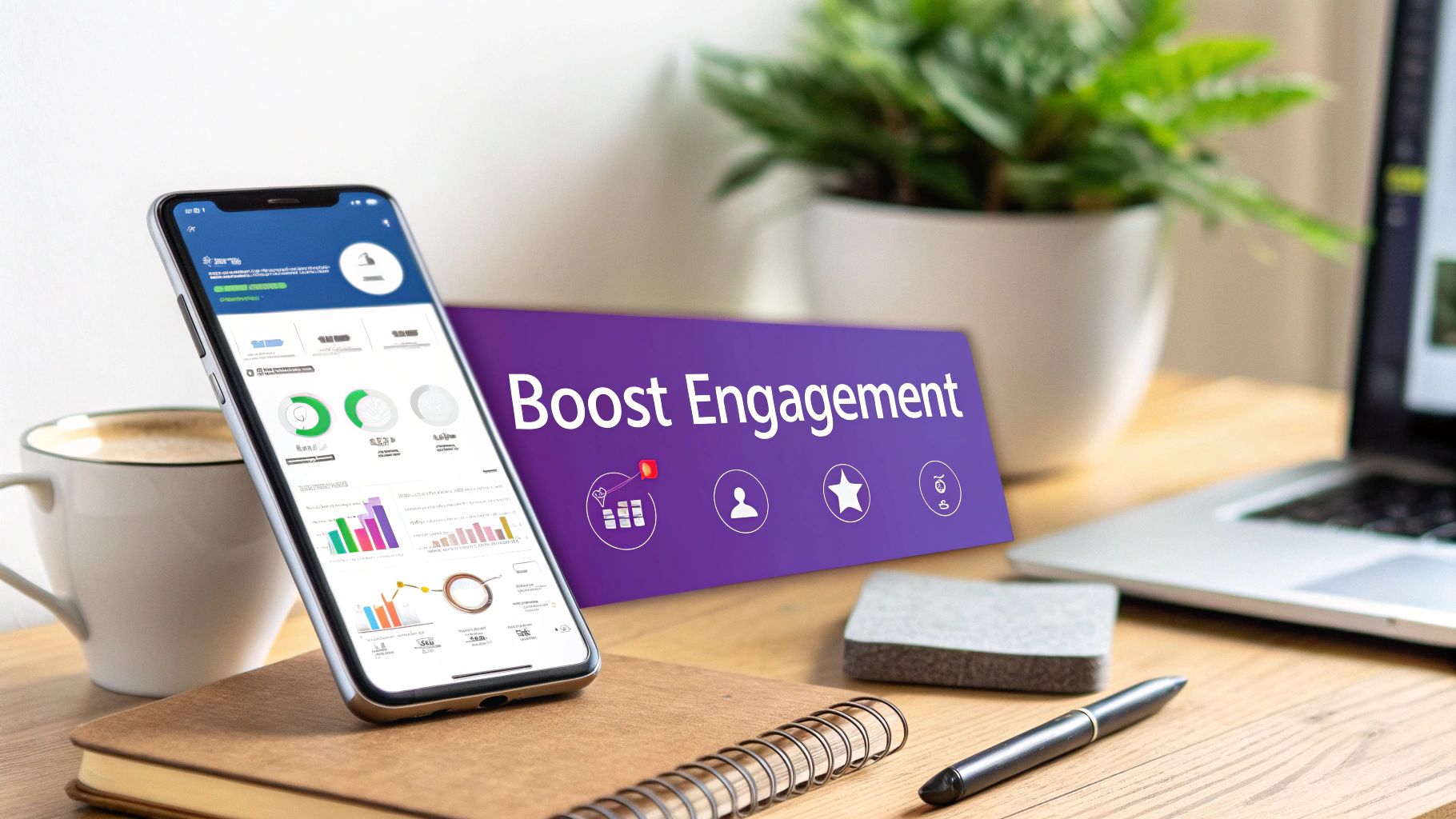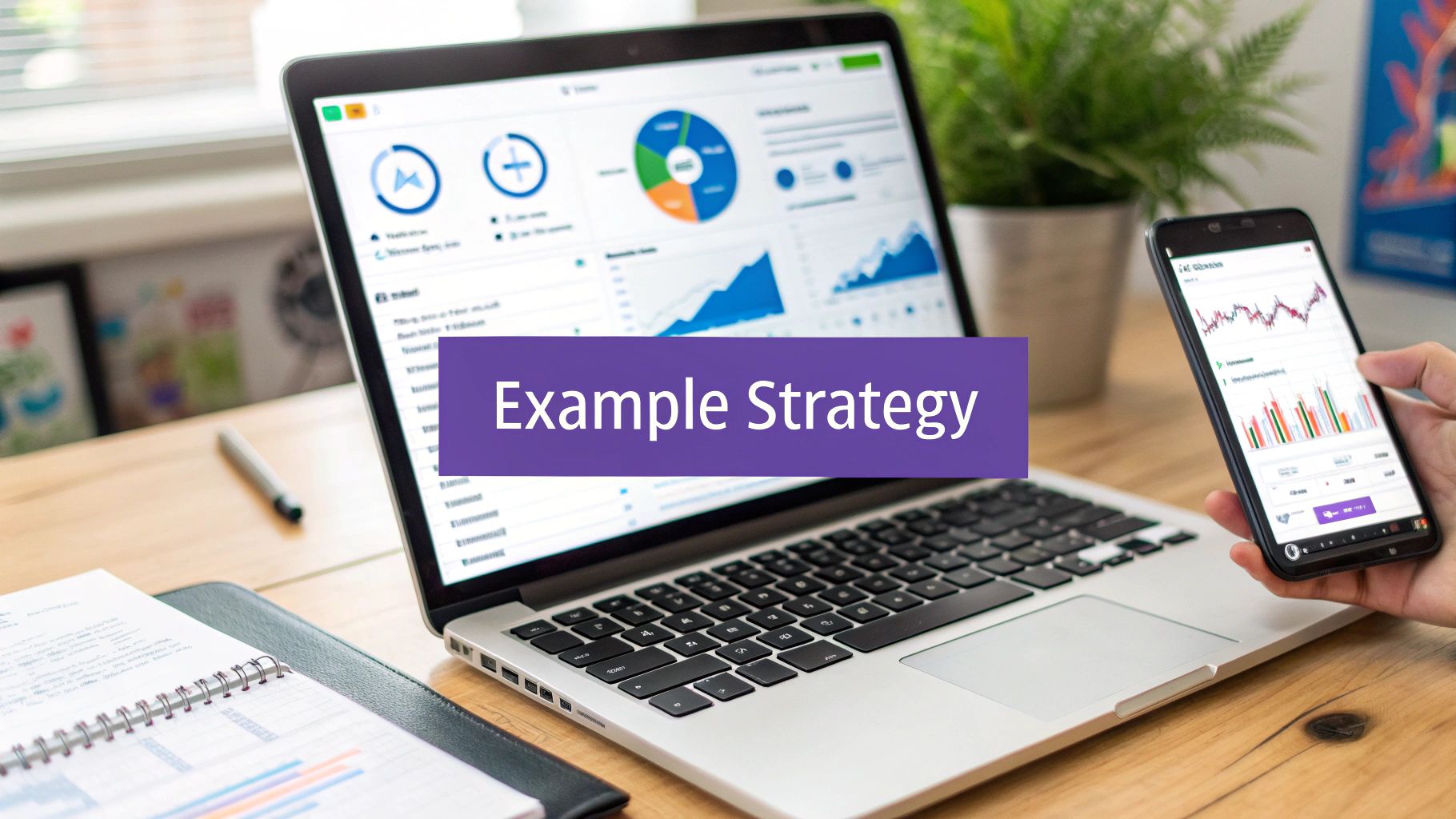LinkedIn Profile Summary Examples to Boost Your Career

Why Your LinkedIn Summary is Your Most Important Career Asset
Your LinkedIn summary isn't just a bio, it's your strategic career narrative, your digital handshake, and your primary tool for capturing the attention of recruiters, clients, and collaborators. A generic, passive summary gets scrolled past in seconds. A powerful, well-crafted one opens doors to opportunities you didn't even know existed. But how do you transform that blank text box into a compelling pitch that commands attention? It's about choosing the right strategic framework, not just listing past duties.
This article moves beyond generic advice to provide a deep dive into specific, proven formulas. We will dissect standout LinkedIn profile summary examples, revealing the tactical psychology behind why they are so effective. Forget vague tips; we are focusing on replicable strategies that work.
You will learn how to apply frameworks like:
- The Problem-Solution-Results Formula
- The Achievement-Focused Approach
- The Client-Centric Service Focus
For each model, you'll get actionable, copy-and-paste templates, empowering you to rewrite your summary for maximum impact. The goal is to give you a clear, structured path to crafting a summary that actively works for you, attracting the right people and opportunities.
1. The Problem-Solution-Results Formula
The Problem-Solution-Results (PSR) formula is one of the most powerful and persuasive structures for a LinkedIn summary. It positions you not just as a professional with skills, but as a strategic solution provider who delivers tangible value. This classic sales and marketing framework hooks readers by immediately addressing a pain point they recognize, establishing your relevance and expertise.
This approach is highly effective because it mirrors the decision-making process of potential clients, recruiters, and hiring managers. They are almost always looking to solve a problem, whether it's cutting costs, increasing revenue, improving efficiency, or reducing risk. By framing your experience within this context, you directly answer their unspoken question: "How can you help me?" This is a fundamental reason why the PSR model is a top-tier choice for LinkedIn profile summary examples.
How the PSR Formula Works
This method is built on a simple, logical progression that tells a compelling story about your professional impact. You start by identifying a common challenge within your industry that your target audience faces. Next, you explain your unique approach, methodology, or the specific skills you use to tackle that problem. Finally, you close with concrete, quantifiable results that prove your effectiveness.
This flow is visualized in the process diagram below, which breaks down how to structure your summary step-by-step.

The infographic illustrates the clear, linear path of the PSR formula, guiding the reader from a relatable challenge to a desirable, proven outcome.
Example in Action: HR Leader
Let's look at how an HR leader might apply this formula:
- Problem: "High-growth tech startups often struggle with employee turnover, losing top talent and institutional knowledge, which slows innovation and drains resources."
- Solution: "I implement data-driven retention strategies focused on career pathing, leadership development, and creating a feedback-centric culture. By using predictive analytics, we can identify at-risk employees and intervene proactively."
- Results: "At my last company, this approach decreased voluntary employee turnover by 45% in 18 months, saving an estimated $1.2M in annual recruitment and training costs and boosting our employee net promoter score (eNPS) by 30 points."
Actionable Takeaways
To implement this formula effectively:
- Research Pain Points: Before writing, identify the top 3-5 challenges your ideal role or client faces. Browse industry forums, read job descriptions, and conduct informational interviews.
- Be Specific with Solutions: Avoid vague terms like "I solve problems." Instead, name the specific methodologies, software, or skills you use.
- Quantify Everything: Use numbers, percentages, and dollar amounts in your "Results" section. This builds credibility and demonstrates a clear return on investment.
2. The Storytelling Narrative
The Storytelling Narrative transforms your professional journey from a simple resume into a compelling story. It humanizes your profile by sharing your career evolution, challenges overcome, and core motivations. This creates an emotional connection with readers and showcases your growth, resilience, and passion in a way a list of skills never could.
This approach is powerful because people are hardwired to connect with stories. A well-told narrative makes you memorable and relatable, helping you stand out in a sea of similar profiles. It’s particularly effective for career changers, entrepreneurs, or seasoned professionals who want to articulate the "why" behind their career path, making it a stellar model for impactful linkedin profile summary examples.

The image above captures the essence of this method: framing your professional timeline not as a series of disconnected jobs, but as a purposeful journey with a clear beginning, a transformative middle, and a future-focused end.
How the Storytelling Narrative Works
This framework organizes your summary into a classic narrative structure. You start by setting the scene with your initial passion or entry into a field. Then, you introduce a turning point or a challenge that sparked a transformation. Finally, you connect your past experiences to your current mission, explaining how your journey equips you to help others now.
This method moves beyond just what you did; it explains why you did it and what you learned along the way. It’s about building a bridge between your history and your future value proposition.
Example in Action: Career Changer (Marketing to UX Design)
Here is how a professional transitioning from marketing to UX design might use a narrative summary:
- Beginning: "For ten years, I crafted marketing campaigns to connect with customers. I loved understanding user behavior, but I often felt disconnected from the product itself, wishing I could influence the user's experience from the very beginning, not just at the end."
- Turning Point (Middle): "The turning point came while leading a campaign for a poorly designed app. Despite our best marketing efforts, user frustration was high. I realized my passion wasn't just in telling the story of a product, but in shaping the story of its use. This led me to dive headfirst into UX design, completing an intensive bootcamp and multiple freelance projects."
- Current Mission (End): "Today, I combine my deep understanding of customer psychology from marketing with my UX design skills to create intuitive, user-centric products. My mission is to bridge the gap between business goals and user needs, ensuring the products we build are not only marketable but truly loved."
Actionable Takeaways
To craft your own compelling narrative:
- Identify Your 'Why': Reflect on what drives you. What is the common thread that connects your different roles or experiences? Start with that core motivation.
- Find Your Turning Point: Pinpoint a specific moment or realization that changed your career trajectory. This creates a compelling hook for your story.
- Connect Past to Present: Explicitly state how your previous experiences, even from different fields, give you a unique advantage in your current role.
- End with a Mission: Conclude with a clear, forward-looking statement about what you aim to achieve for your clients, employer, or industry. This transforms your story from a reflection into a powerful value proposition.
3. The Achievement-Focused Approach
The Achievement-Focused approach is a data-driven strategy that leads with your most impressive numbers, awards, and quantifiable accomplishments. It immediately establishes credibility and expertise by showcasing concrete results, making it ideal for competitive industries where measurable outcomes are highly valued. This method cuts through the noise by prioritizing proof over promises.
Instead of describing your responsibilities, you spotlight the direct impact you made. This is powerful because it speaks the language of business leaders and recruiters: results. It’s a direct answer to their primary concern, "What have you actually accomplished?" By leading with metrics, you frame your professional narrative around value creation, making this a top-tier model for effective LinkedIn profile summary examples.

This approach is particularly effective for professionals in roles where performance is tracked with hard data, such as sales leaders, marketing managers, and operations experts.
How the Achievement-Focused Approach Works
This method works by transforming your LinkedIn summary into a highlight reel of your career's greatest hits. It shifts the focus from what you did (your duties) to what you achieved (your results). The structure is often a powerful opening statement followed by a series of bullet points that quantify your key contributions.
The goal is to provide undeniable evidence of your capabilities right away. A recruiter scanning your profile can immediately see the tangible value you bring, such as revenue generated, costs saved, or efficiency gained. This directness builds instant trust and makes you a more compelling candidate.
Example in Action: Sales Professional
Let’s see how a top-performing Sales Professional would apply this formula:
- Powerful Opener: "Award-winning SaaS Sales Executive with a 10-year track record of exceeding quotas and driving multimillion-dollar revenue growth in competitive enterprise markets."
- Key Achievements (Bulleted):
- Achieved 175% of quota in FY2023, generating $2.5M in new ARR.
- Ranked #1 Sales Director out of 50 in the North American region for two consecutive years.
- Expanded into three new international markets, securing anchor clients that led to a 40% increase in regional market share.
- Reduced the average sales cycle from 90 days to 65 days by implementing a new value-based selling framework.
Actionable Takeaways
To implement this data-driven formula:
- Start with a Bang: Open with a strong headline statement that summarizes your core value proposition and includes a major achievement.
- Use Specific Numbers: Replace vague claims like "improved sales" with concrete metrics like "Increased qualified leads by 300% in 6 months."
- Provide Context: Don't just list a number. Briefly explain how you achieved it. For example, mention the strategy or project that led to the result.
- Update Regularly: Keep your summary fresh by adding your latest and most impressive accomplishments as they happen.
4. The Expertise Authority Positioning
The Expertise Authority Positioning approach elevates your profile beyond a simple resume by establishing you as a thought leader and go-to expert in your field. Instead of just listing what you do, you showcase what you know. This strategy is about demonstrating deep intellectual capital, sharing unique insights, and highlighting your contributions to the broader industry conversation.
This method is particularly powerful for consultants, industry analysts, academics, and senior professionals whose value is tied directly to their specialized knowledge. It helps you attract high-quality opportunities, speaking engagements, and consulting projects by building trust and credibility before the first message is even sent. It directly answers the question, "Why should I listen to you?" making it one of the most effective linkedin profile summary examples for knowledge-based professionals.
How Expertise Authority Positioning Works
This strategy focuses on broadcasting your deep understanding of a niche topic. You achieve this by framing your experience around your intellectual contributions rather than just your job duties. You highlight publications, speaking events, proprietary frameworks, and forward-looking industry commentary to prove your authority. This creates a magnetic brand that pulls in an audience looking for your specific expertise.
The goal is to move from being a participant in your industry to being a definitive voice that shapes it. You are not just a "Marketing Director"; you are "a leading authority on B2B SaaS product-led growth."
Example in Action: Cybersecurity Consultant
Let's see how a cybersecurity consultant might apply this positioning:
- Core Expertise: "As a Cybersecurity Strategist, I specialize in defending critical infrastructure within the energy sector against state-sponsored threats. My focus is on proactive threat modeling and building resilient security architecture for OT/ICS environments."
- Authority Signals: "I'm the author of 'The Digital Fortress: Securing Energy Grids in the 21st Century' and a frequent speaker at industry conferences like Black Hat and DEF CON. I've developed the 'Adaptive Threat Response' framework, a proprietary methodology for dynamic risk mitigation."
- Forward-Looking Insight: "Currently tracking the convergence of AI-driven attack vectors and IoT vulnerabilities in industrial settings. Passionate about shaping policy and best practices to ensure a secure and reliable energy future."
Actionable Takeaways
To implement this formula effectively:
- Claim Your Niche: Be hyper-specific. Instead of "digital marketing expert," try "expert in customer lifecycle marketing for D2C e-commerce brands."
- Show, Don't Just Tell: Mention specific publications, talks, podcasts, or influential projects. If you developed a unique model or process, name it and briefly explain its value.
- Share Your Perspective: Include a sentence about a key trend you are following or an opinion you hold about the future of your industry. This demonstrates forward-thinking leadership.
5. The Client-Centric Service Focus
The Client-Centric Service Focus flips the traditional summary on its head. Instead of talking about yourself, your skills, or your history, you make it all about your client. This approach positions you as a dedicated partner whose primary goal is understanding and solving your client's specific needs, challenges, and aspirations. It shifts the spotlight from "me" to "you," creating an immediate connection with your target audience.
This method is exceptionally powerful for service-based professionals, consultants, coaches, and freelancers. It works because it directly addresses the reader's self-interest. Potential clients are looking for someone who "gets" them and can deliver the outcomes they desire. By dedicating your summary to their world, you demonstrate empathy and a deep understanding of their business, making you a far more attractive choice than a competitor who simply lists their own credentials. This focus on client outcomes is why it's one of the most effective linkedin profile summary examples for building trust and generating leads.
How the Client-Centric Focus Works
This strategy involves defining your ideal client with precision and speaking directly to them. You articulate their problems in their own language, show that you understand their goals, and explain how your service acts as the bridge between their current state and their desired future. The entire narrative is framed from their perspective, highlighting benefits over features.
It's about building a relationship before the first message is even sent. You are not just a service provider; you are an advocate for their success.
Example in Action: Financial Advisor
Let's see how a financial advisor targeting tech professionals might use this approach:
- Problem (Framed for the client): "As a tech leader, you're an expert at building innovative products, but navigating complex equity compensation like RSUs, ISOs, and NSOs can feel like a second full-time job. You worry about making a costly tax mistake or leaving money on the table."
- Solution (Focused on client benefit): "I help tech professionals like you create a clear, strategic financial plan that maximizes your unique compensation structure. We'll build a roadmap to turn your hard-earned equity into long-term wealth, whether your goal is early retirement, funding a startup, or securing your family's future."
- Results (Showcasing client success): "My clients gain the clarity and confidence to make smart financial decisions, often saving five to six figures in taxes and accelerating their wealth-building goals by years. Let's connect for a complimentary discovery call to map out your financial future."
Actionable Takeaways
To implement this formula effectively:
- Define Your Ideal Client: Get hyper-specific. Are they early-stage founders? Marketing VPs in SaaS? Be so clear that your ideal client feels like you're speaking directly to them.
- Use "You" and "Your": Scour your summary and replace "I" and "my" with "you" and "your" wherever possible. This simple change instantly makes the summary more client-centric.
- Focus on Transformation: Don't just list what you do (features). Describe the transformation your clients experience (benefits). Instead of "I provide SEO services," say "I help you attract your ideal customers through Google."
- Include a Clear Call-to-Action: Since this approach is about starting a conversation, end with a clear, low-friction next step, like booking a discovery call or downloading a helpful resource.
6. The Personal Brand Statement
The Personal Brand Statement approach transforms your LinkedIn summary into a concise, powerful declaration of your professional identity. It distills your core values, unique value proposition, and professional mission into a memorable tagline. This method moves beyond a simple list of skills, instead focusing on the "why" behind your work and what you fundamentally stand for in your industry.
This style is particularly effective for leaders, creatives, and entrepreneurs who want to build a following and attract opportunities aligned with their specific worldview. It immediately communicates your essence, helping you connect with like-minded professionals, clients, or employers who share your vision. By clearly articulating your brand, you make it easier for your target audience to understand your unique contribution, making this one of the most strategic linkedin profile summary examples for differentiation.
How the Personal Brand Statement Works
This formula centers on authenticity and clarity. The goal is to create a short, impactful statement that encapsulates your professional philosophy. It should be aspirational yet grounded in your experience, serving as the north star for your entire professional presence. You are defining who you are, who you serve, and the principles that guide your work.
This approach is less about a chronological history and more about a thematic promise. It answers the question, "What is the one thing I should know about you professionally?"
Example in Action: Creative Director
Let's examine how a creative director might use this approach to define their brand:
- Core Value & Mission: "I believe that great design isn't just about aesthetics; it's about empathy. My mission is to build brands that connect with people on a human level, creating memorable experiences that foster loyalty and drive meaningful engagement."
- Unique Value Proposition: "I combine strategic market insights with a passion for storytelling to lead creative teams in translating complex business goals into simple, beautiful, and effective design systems."
- Professional Philosophy: "My approach is rooted in collaborative innovation and a relentless pursuit of clarity. I empower designers to take creative risks while ensuring every pixel serves a purpose, ultimately bridging the gap between brand promise and customer reality."
Actionable Takeaways
To craft a compelling Personal Brand Statement:
- Define Your Core Values: List 3-5 non-negotiable principles that guide your professional decisions. Think about words like "integrity," "innovation," "sustainability," or "community."
- Articulate Your Mission: In one sentence, describe the impact you want to make in your field. Why do you do what you do?
- Make It Quotable: Aim for a statement that is memorable and easily repeated. Read it aloud to ensure it sounds natural and confident.
- Ensure Alignment: Your brand statement must be consistent with your experience, skills, and the content you share. It should be an authentic reflection of your professional identity.
7. The Skills-First Technical Approach
The Skills-First Technical Approach is a direct and highly effective strategy for professionals in technology, engineering, data science, and other fields where specific competencies are non-negotiable. This method prioritizes a clear, organized list of your most relevant technical skills, certifications, and tool proficiencies at the forefront of your summary. It functions like a powerful, contextualized resume headline that immediately signals your qualifications to recruiters and hiring managers who are often searching for specific keywords.
This approach works so well because it aligns perfectly with how technical roles are sourced and filled. Recruiters frequently use keyword-based searches on LinkedIn to find candidates with precise skills like "Python," "AWS Certified Solutions Architect," or "Google Analytics." By leading with these terms, you optimize your profile for discoverability and instantly validate your fit for a role, making this a crucial model for technical linkedin profile summary examples.
How the Skills-First Approach Works
This method organizes your expertise into logical categories, making it easy for a reader to scan and confirm your capabilities in seconds. Instead of burying your technical prowess in narrative paragraphs, you present it upfront. You begin with a brief introductory sentence, followed by clearly labeled skill groups. This structure ensures that your most critical qualifications are seen first, before a reader even has to scroll.
The goal is to provide a comprehensive yet skimmable inventory of your technical toolkit, immediately answering the primary question in a recruiter's mind: "Does this person have the hard skills we need?"
Example in Action: Data Analyst
Let's see how a Data Analyst could use this skills-first summary:
- Introduction: "Data Analyst with 5+ years of experience transforming complex datasets into actionable business insights that drive strategic decision-making and operational efficiency."
- Technical Skillset:
- Programming & Databases: Python (Pandas, NumPy, Scikit-learn), R, SQL, NoSQL (MongoDB)
- Data Visualization & BI Tools: Tableau, Power BI, Looker, Matplotlib
- Cloud & Big Data: AWS (S3, Redshift), Azure, Apache Spark
- Statistical Analysis: A/B Testing, Regression Modeling, Predictive Analytics
- Business Impact: "Proven ability to build and automate dashboards that led to a 15% reduction in marketing spend and a 20% increase in lead conversion rates."
Actionable Takeaways
To implement this formula effectively:
- Group Skills Logically: Organize your skills into relevant categories such as "Programming Languages," "Software," "Cloud Platforms," or "Certifications." This makes your profile highly scannable.
- Be Specific and Current: Don't just list "Cloud Computing." Specify "AWS," "Azure," or "GCP." Keep your skills list updated with the latest versions and tools relevant to your industry.
- Add Context and Impact: After your skills list, add a brief sentence or two connecting these skills to a tangible business outcome or achievement. This shows you don't just know the tools; you know how to apply them to create value.
7 LinkedIn Summary Styles Comparison
Approach | Implementation Complexity 🔄 | Resource Requirements ⚡ | Expected Outcomes 📊 | Ideal Use Cases 💡 | Key Advantages ⭐ |
|---|---|---|---|---|---|
Problem-Solution-Results Formula | Moderate – Structured three-part flow | Moderate – Requires measurable results | Clear value proposition with concrete metrics | Sales professionals, consultants, business owners | Captures attention fast; logical flow; value-focused |
Storytelling Narrative | Moderate to High – Crafting engaging story | Low to Moderate – Personal insights needed | Emotional connection and memorable narrative | Career changers, entrepreneurs, creatives | Builds authenticity; differentiates profile |
Achievement-Focused Approach | Low to Moderate – Highlighting key metrics | Moderate – Needs quantifiable data | Strong credibility with measurable success | Sales, executives, analysts, performance roles | Establishes expertise; easy to scan; trust-building |
Expertise Authority Positioning | High – Requires deep expertise & ongoing input | High – Content creation & credentials | Positions as thought leader with industry influence | Consultants, analysts, academics, executives | Attracts opportunities; builds high-level authority |
Client-Centric Service Focus | Moderate – Focus on client outcomes | Moderate – Understanding clients well | Builds trust through client focus and value demonstration | Consultants, coaches, service providers | Strong client resonance; service oriented; trust builder |
Personal Brand Statement | Low – Concise and focused | Low – Clear articulation | Strong brand recognition and memorable positioning | Executives, creatives, entrepreneurs | Easy to remember; differentiates; versatile use |
Skills-First Technical Approach | Low to Moderate – Listing and organizing skills | Moderate – Skills and certifications inventory | Clear demonstration of competencies | Developers, engineers, IT professionals | Recruiter-friendly; keyword optimized; shows expertise |
From Examples to Execution: Your Next Steps to a Perfect Profile
We've journeyed through a diverse collection of powerful LinkedIn profile summary examples, moving far beyond surface-level descriptions to dissect the strategic architecture that makes them effective. The ultimate takeaway is clear: a standout summary is never accidental. It is a calculated, purpose-driven asset engineered to attract specific opportunities and resonate with a target audience.
From the direct impact of the Problem-Solution-Results formula to the engaging pull of a well-crafted Storytelling Narrative, each framework serves a unique purpose. Your summary isn’t just a block of text; it's the strategic core of your professional brand on the world's largest professional network. It’s your digital handshake, your elevator pitch, and your credibility statement all rolled into one.
Synthesizing the Strategies: Your Action Plan
The examples in this article demonstrate that there is no single "best" way to write a summary, only the best way for you. Your task now is to transition from analysis to action. Don't let the variety of options lead to paralysis. Instead, use it as a toolkit to build a summary that is authentically and strategically yours.
Here are your immediate next steps:
- Define Your Core Objective: What is the number one thing you want your profile to achieve? Is it attracting recruiters for a specific role, generating freelance leads, or establishing thought leadership? Your goal dictates your strategy.
- Select Your Primary Framework: Review the models we covered, such as the Achievement-Focused Approach or the Client-Centric Service Focus. Choose the one that aligns most closely with your objective and industry norms. You can even blend elements from two different frameworks.
- Draft, Don't Perfect: Open a blank document and write your first version. Don't overthink it. Focus on getting your key accomplishments, skills, and value proposition down on paper. The goal is to create a solid foundation you can refine.
- Refine and Optimize: Let your draft sit for a day, then come back to it with fresh eyes. Polish your sentences, check for clarity, and ensure your most important keywords are naturally integrated. Read it aloud to catch awkward phrasing.
The Lasting Impact of a Strategic Summary
Mastering your LinkedIn summary is more than just a profile tweak; it's an investment in your career trajectory. A well-optimized summary works for you 24/7, connecting you with opportunities while you sleep. It ensures that when the right person, be it a hiring manager, a potential client, or a future business partner, lands on your profile, they immediately understand your value and how you can help them. This is the key to unlocking inbound opportunities and taking control of your professional narrative.
The difference between a generic summary and a strategic one is the difference between being a passive participant and an active architect of your career. Take the insights from these LinkedIn profile summary examples and build a summary that doesn't just list your experience but sells your expertise.
Tired of the trial-and-error? If you want to accelerate this process and generate a summary built on proven, high-performer data, check out MakerBox. It uses AI to craft compelling, optimized profile summaries in seconds, taking the guesswork out of personal branding. Unlock your perfect profile today at MakerBox.





